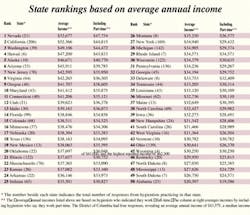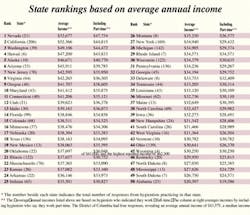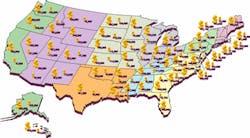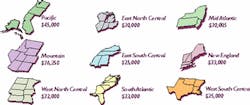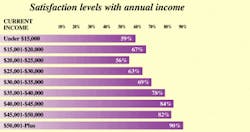Top dollar, Low benefits
2,761 RDH readers shared information about their income and benefits. Satisfaction with salaries is high, but contentment with benefits is more questionable.
Mark Hartley
data compilation by
Julie Harris and
Vicki Cheeseman
Does $37,000 a year - with some change left over for gasoline and parking - sound about right? If $37,619 is close to your annual income, you qualify for the term that emerges from any survey - average. Or you may be closer to the fringe. The RDH salary and benefits questionnaire, published in the May 1996 issue, revealed annual incomes as high as $85,000 and as low as $1,500.
The personal financial information was provided by 2,761 RDH readers. In between the financial extremes are the "average" wage earners who are not that distant from their 40th birthday, who work exclusively as dental hygienists with no sideline source of income, who toil "full-time" for an hourly rate, who are happy with the pay, and who wish the doctor would invest more money in either ultrasonic scalers or intraoral cameras.
The second part of the survey addressed benefits, and the level of contentment barely constitutes a majority. RDH asked readers if they were "generally satisfied" with employer benefits, and only 53 percent answered positively. The large minority apparently based their answer on the fact that health care insurance, paid sick days, and profit-sharing or pension options are an exception rather than the rule in dentistry.
On the other hand, paid vacations and holidays, as well as financial assistance with continuing education, are more commonplace.
Go west, where the pay`s good
The RDH survey hints at better pay in the western half of the United States. In the west, California hygienists dominated the total number of responses. The state accounted for 39 percent of the responses from that region which includes the Rocky Mountain states and all land west of them. The 206 Californians participating in the survey, however, were overshadowed by 21 hygienists in Nevada. The average annual income of full-time Nevada hygienists is $52,677 - the highest state average reported. One Nevada hygienist also reported the highest annual income - $85,000 a year.
California is second highest with an average of $52,366. The average annual income exceeded $40,000 in the other Pacific region states too -- Alaska, Washington, Oregon, and Hawaii. Arizona ($45,911) joins Nevada among the Mountain region states breaking the $40,000 average, and, Utah ($39,623), Idaho ($39,163), Colorado ($38,511), and New Mexico ($38,063) were just shy of the $40,000 average for full-time hygienists.
New Jersey ($42,595), Virginia ($42,265), Maryland ($41,412), Connecticut ($41,206) were the other states reporting an average annual income of more than $40,000.
The District of Columbia had four respondents reporting an average of $43,575.
On the other side of the wage scale, readers from five states collectively reported incomes below $30,000 - Kentucky ($29,950), North Dakota ($27,850), Mississippi ($27,626), South Dakota ($26,750), and Alabama ($20,507). The highest annual income reported in Alabama was $32,000.
One possible reason for discrepancies in income levels is the level of experience dominating a state`s responses. In states with more than 10 responses, the level of work experience was generally evenly distributed. Alabama is an exception, since 13 of the 31 responses (42 percent) have worked for less than five years. Other exceptions include Louisiana (32 percent under five years), Indiana (32 percent under five years), Utah (57 percent under 10 years), Maryland (20 percent over 25 years), and West Virginia (31 percent over 25 years).
The experience level of the 21 hygienists responding from Nevada also is worth noting. Twelve (57 percent) have worked for less than 10 years, and five (24 percent) have worked 21 to 25 years in dental hygiene. The hygienist reporting the $85,000 annual income checked off the option for 16 to 20 years experience.
The $20,000 disparity between Alabama and the West Coast apparently plays a role in "satisfaction" with current salaries. The regional grouping of Alabama, Mississippi, Kentucky and Tennessee reflected a 52 percent satisfaction with salaries, while the grouping of California, Oregon, Washington, Hawaii, and Alaska revealed an 81 percent satisfaction with salaries. The Mountain states were the next highest at 80 percent, and the Midwest area from Texas to Minnesota, as well as New England, reflected satisfaction with salaries in the 70 percent range. The Great Lakes states and mid-Atlantic states, though, were in the 60 percent range.
Eighty-three percent of hygienists work for an hourly rate or a daily rate. Seven percent earn an annual salary, and 8 percent work on a commission basis.
The survey points out a trend that, as annual income increases, there is less likelihood of earning income through an hourly rate. The percentage of hygienists working by the hour is highest for those earning less than $20,000 annually (59 percent). The lowest percentage (28 percent) is for hygienists earning more than $50,000. The percentage consistently decreases through each higher income bracket suggesting that hygienists with higher incomes are less likely to get paid by the hour.
The amount of annual income does not influence any trends pertaining to daily rates, fixed annual salaries or commission. Hygienists earning more than $50,000 annually, though, had the highest percentages of income based on a daily rate (43 percent) or commission (18 percent). In another income bracket, $30,000 to $35,000, 10 percent are paid an annual salary - the highest such percentage.
Geography plays a role in determining income schedules. Dentists in the Northeast and Great Lakes states overwhelmingly pay on a hourly basis. The "hourly wage" is slightly more popular in the Mountain states too, but the Pacific Coast states pay hygienists on a daily rate basis. States favoring the daily rate in the East resemble the Confederacy in a Civil War map. The exceptions are that West Virginia, Kentucky, and Maryland are part of the "South" while Missouri is part of the North.
Gender also could be a minor factor. Of the 16 male hygienists who responded, only three (20 percent) are paid on an hourly basis. Five are paid on a daily rate, and five receive a fixed annual salary. Although a comparison of 16 male hygienists with 2,736 female hygienists presents statistical imbalances, 33 percent of the males are paid an annual salary compared to 7 percent of the women.
Nationally, the percent of production paid to hygienists working on a commission basis averaged 39 percent. The most common answers in all but the New England region (which averaged 35 percent of production), though, were 40 or 50 percent of production. Hygienists who work on commission reported a greater satisfaction (85 percent) with their income than other income schedules. Hygienists who earn income through an hourly rate, daily rate, or fixed annual salary reported satisfaction levels ranging from 67 percent to 70 percent.
Hygienists who belong to the American Dental Hygienists` Association reported generally higher salaries than non-members or former members, earning an average of $34,994. Non-members had an average of $31,185 while the average pay of former members was $32,815. Not surprisingly, ADHA members are more satisfied with their salaries (75 percent) than non-members (67 percent) and former members (70 percent).
Thirteen percent of the readers said they supplement their dental hygiene income through sideline businesses or other careers. While many indicated they were fitness instructors, in sales of cosmetics or dental products, the majority ranged from the mundane to the exotic. Examples of the former include cashiers and waitresses, landlords and realtors, landscaping or interior decorating, investors, and secretaries. Some unique occupational pastimes include naturalists, artists, ranchers, commercial fishermen, and instructors of skiing, scuba diving, martial arts, and basketweaving.
Where are the perks?
The West may draw better wages, but the East gets the perks. Western hygienists get less time off to enjoy their higher wages - or, at least, paid to enjoy it. Paid vacation time is extended to only 54 percent of hygienists from the Pacific states and 66 percent of hygienists in the Mountain states. These percentages pale to the approximately 75 percent of hygienists receiving paid vacation in the rest of the country.
Nationally, breakdown on paid vacation time is as follows:
- 33 percent receive two weeks.
- 17 percent are offered three weeks.
- 16 percent can take one week of paid vacation.
- 5 percent have the option of four weeks or more.
Unfortunately, the geographical trend referred to above also applies to paid holidays. Only 41 percent of hygienists in the Pacific states are paid for holidays. Elsewhere, 66 percent are being paid while they celebrate holidays.
Hygienists could justifiably argue for themselves as well as patients the next time health care insurance becomes part of the profession`s lobbying efforts. Sixty percent of the profession is not provided health care insurance by their employers. Approximately 70 percent of hygienists employed in the region from Texas and Oklahoma to Alabama up through Kentucky are not insured. The lowest percentage of uninsured hygienists is in the mid-Atlantic region of New York, Pennsylvania, and New Jersey (55 percent).
Most employers who provide health care insurance do pay all premiums (59 percent). If they don`t, employers typically pay half of the premiums. Traditional 80/20 plans remain the most popular type of insurance offered (38 percent), but many hygienists reported the availability of HMO (21 percent) and PPO plans (18 percent). Under the majority of plans (54 percent), dependent coverage is not available.
Urban hygienists tend to receive health care insurance (46 percent) more than suburban (38 percent) or rural practitioners (39 percent).
When hygienists do get sick, the majority (57 percent) are not paid while recuperating. Hygienists working the eastern seaboard states have the best chance of obtaining paid sick leave, ranging from 57 percent in the New England states to 51 percent in the southern Atlantic states. Again, western states offer this benefit the least. Only 32 percent of those employed in the Pacific states receive paid sick leave. The percentage increases slightly to 34 percent for the Mountain states and the region comprising Texas, Oklahoma, Arkansas, and Louisiana.
Nine of the 16 male hygienists responding said they receive paid sick leave. This 56 percent is higher than the 43 percent of female hygienists receiving the benefit. Otherwise, the gender-based percentages regarding benefits were essentially identical.
The RDH survey also inquired if employers offer a pension plan, a 401(k) program, or a profit-sharing program. Only 49 percent of readers responded to the question. Of this group of 1,338 hygienists who responded, 44 percent participate in a pension plan, 25 percent partake of a 401(k) option, and 21 percent share in practice profits.
On a nation-wide basis, benefits are not necessarily extended to lower-income levels in exchange for higher income. Of the 29 percent who do not receive paid vacation, 54 percent earn less than $30,000 a year. Of the 37 percent who do not get paid holidays, 53 percent earn less than $30,000 a year. Of the 60 percent who are not provided health care insurance, 49 percent earn less than $30,000 a year. Of the 57 percent who do not receive paid sick leave, 47 percent earn less than $30,000 a year.
CEUs, dues, and shoes
A question regarding out-of-pocket business expenses required handwritten answers. Shoes and expenses relating to continuing education were the two most common answers. Licensure renewal and professional association dues also were frequently noted. Most of the responses are listed below, followed by a number indicating the number of times readers wrote the answer:
- Continuing education expenses (740).
- Footwear (415).
- Fees associated with licensure (320).
- Dues associated with membership in a trade association (248).
- Malpractice insurance (199).
- Other types of insurance (143).
- Protective eyewear (74).
- Laundering expenses for uniforms (49).
- Dental instruments or equipment (42).
- Subscriptions to journals (32).
- Lab coats, scrubs, smocks, etc. (25).
- Prizes for kids or oral care product samples (21).
- Expenses for CPR recertification (13).
- Patient education materials (11).
- Small operatory supplies (11).
- Parking (10).
- Retirement Plans (8).
- Supplies such as professional stationery, business cards, etc. (8).
Many of the entries under "other types of insurance" were simply "insurance." But, when specifically spelled out, hygienists noted premiums for life, health, and disability insurance plans.
Single answers regarding out-of-pocket expenses included "honing machine and repairs," "operatory decor," "retipping instruments," immunizations and other related medical tests, books, plants, other clothing items such as pants and "shirt under lab coat," and assorted transportation costs in addition to parking. Some interesting answers included "CD selection for background music," "7-inch fan for when it gets hot," and "gifts for dentist."
But clearly most of the business expenses are related to continuing education requirements, comfortable "sneakers" for work, and license renewal. Many of the responses for continuing education indicated an arrangement with the employer who would pay for:
- Seminars of direct interest to the dental practice.
- The seminar itself but the hygienist is expected to pay all related travel expenses.
- A percentage of all expenses.
In a separate question, the survey asked readers if the employer pays for continuing education required for licensure. Sixty-four percent do receive assistance from the dentist for continuing education. Northern states (stretching from New England to Kansas and up to the Dakotas) tend to offer this assistance more frequently (approximately 70 percent). Only 53 percent of employers in the Pacific states of California, Alaska, Hawaii, Oregon, and Washington pay for continuing education necessary for relicensure.
The survey also queried hygienists about dental instruments or equipment they wished the dental office would purchase. By far, ultrasonic scalers, air polishers, and intraoral equipment dominated the wish lists. Other suggestions focused on operatory lighting or size, X-ray equipment, and back office computers. But requests for newer products, such as illuminated mirrors and automated probes, also surfaced. Many hygienists simply wrote, "I have everything I need," indicating a general opinion that their employers are doing everything possible to stay updated.
All the live-long day
Hygienists, for the most part, work 21 to 35 hours a week (57 percent). Only 27 percent indicated they work more than 36 hours a week. Since much of the nation`s work force labors a minimum of 40 hours a week to earn "full-time wages," a question was asked about hygienists` perceptions of themselves as full-time or part-time employees. Sixty-eight percent "view" themselves as "full-time" employees. This perception changes as the years pass by, since 85 percent of hygienists who have started practicing within the last five years view themselves as full-time employees, while 40 percent of those employed in the profession for more than 25 years view themselves as part-time employees.
But other occupations typically do not need to arrive at 7:30 a.m. in order to be "ready for work" at 8 a.m. When the whistle blows at 5 p.m., other workers usually can leave promptly - unlike many hygienists. They also enjoy a one-hour lunch break, as well as mid-morning and mid-afternoon breaks. So a hygienist`s 32-hour schedule may not reflect all of the demands of the job.
The perception of full-time vs. part-time also slightly changes based on the location of the workplace. In urban and rural areas, at least 72 percent of hygienists view themselves as full-time. In suburban areas, the figure drops to 63 percent.
A breakdown of the data about hygienists` workweeks also reveals:
- The answer given most often was 32 hours a week.
- Only three percent work less than 10 hours a week.
- Thirty-nine percent work between 11 and 30 hours a week.
- The average number of hours worked per week decreases slightly as hygienists become more experienced. Hygienists who have received their license within the last five years indicate they work an average of 33 hours per week.
The 437 hygienists who have practiced for more than 25 years work an average of 29 hours per week.
- The workload for the average hygienist is nine patients a day. Fifty-four percent said they treat seven to nine patients a day. Thirty-eight percent indicate they treat 10 to 15 patients a day.
The number of work hours a week coincides with the average workload. Nine patients a day times 45 minutes per patient equals 333/4 hours a week.
A prevailing concept in dental practice management is to pair the hygienist with a dental assistant in an effort to boost the hygienist`s productivity. However, the survey indicated little actual implementation of the concept - only 128 hygienists responding (5 percent) work full-time with an assistant. In some practices, assistants record probing scores (13 percent) and 21 percent indicated they "occasionally" work with an assistant. But the most common answer coming from 61 percent was that they "never" work with an assistant.
Hygienists who do work with an assistant treat an average of 12 patients a day. They also earn more money, an average of $37,874 annually - about $6,000 a year more than those who do not.
In summary, the highest levels of satisfaction with salaries and benefits were among hygienists who:
- practice in Alaska, Arizona, Idaho, Nevada, Oregon, and Washington.
- are in their first five years working in clinical hygiene.
- belong to the American Dental Hygienists` Association.
- work in urban practice settings.
- treat seven to nine patients a day.
- earn more than $50,000 annually.
- are paid on a commission basis.
About this survey
Demographic information about who responded to the survey published in the May 1996 issue includes:
- 2,761 readers responded - or 4 percent of the magazine`s readership.
- The average age was 39. The youngest hygienist responding was 21 years old, and the oldest was 73 years young.
- 16 male hygienists responded, meaning 99 percent of the survey questions were answered by female hygienists.
- Hygienists in California (221), New York (188), and Michigan (154) contributed the most responses on a per-state basis.
Wyoming (5), South Dakota (7), Rhode Island (8), Montana (8), and Hawaii (8) contributed the fewest.
Michigan led a cluster of states in the upper Midwest - Ohio (148), Illinois (130), and Wisconsin (129) - with a heavy response, so the East North Central region represents 23 percent of the total.
- Most respondents (54 percent) are employed in suburban practices. Urban practices (26 percent) and rural practices (20 percent), of course, make up the rest of the practice settings.
- In terms of experience as a licensed hygienist, 18 percent were licensed within the last five years, 18 percent within six to 10 years, 17 percent within 11 to 15 years, 18 percent within 16 to 20 years, 13 percent within 21 to 25 years, and 16 percent first obtained a license more than 25 years ago.
- 88 percent said they are employed by general dentists. Of the remaining group of 332 hygienists, 173 work for periodontists.
The breakdown of other specialties included pediatric dentists (66), orthodontists (56), prosthodontists (20), public health (32), endodontists (5), and oral surgeons (1). One respondent indicated that she is in independent practice as a hygienist.
- Most of the respondents are the only hygienist in a practice (30 percent) or work with one other part-time or full-time hygienist (35 percent); 18 percent indicated they work with two other hygienists, and 12 percent said they practice with three to five other hygienists. Only 4 percent said they practice with more than five hygienists.
- Most of the hygienists responding do not belong to the American Dental Hygienists` Association. Only 37 percent said they belong to the association, 36 percent said they do not belong, and 27 percent indicated they are former members.
Q&A
How many dental practices do you work for?
- 74% - 1
- 21% - 2
- 5% - 3 or more.
Do you work with a dental hygiene assistant?
- Never - 61%
- Only to record probing scores - 13%
- Occasionally - 21% - Full time - 5%
What is the average number of hours a week
- 27% - 21-30 hrs. you personally practice?
- 31% - 31-35 hrs.
- 28% - 36+
Do you view yourself as a part-time
- Part-time-32%
- Full-time-68% or full-time hygienist?
What is the average number of patients
- 54% - 7-9
- 38% - 10-15 you treat each day?
Does your employer pay you by:
- Hourly rate - 53%
- Daily rate - 30%
- Fixed annual salary - 7%
- Other - 2%
- Commission - 8%
Are you generally satisfied with the salary you
- Yes - 70%
- No - 30% earn as a dental hygienist?
How many weeks of paid vacation do you
- None - 29%
- 3 weeks - 17% receive each year?
- 1 week - 16%
- 4 weeks or more - 5%
- 2 weeks - 33%
Do you receive paid holidays?
- Yes - 64%
- No - 37%
Does your employer provide health-care insurance?
- Yes - 40%
- No - 60%
Does your employer provide paid sick leave?
- Yes - 43%
- No - 57%.
Does your employer pay for continuing education
- Yes - 64%
- No - 36% required for relicensure?
Does your employer provide a pension plan,
- Pension plan - 45% 401 K, profit sharing program or other?
- 401(k) program - 25%
- Profit-sharing program - 21%
- Other - 10%
Are you generally satisfied with the employer
- Yes - 53%
- No - 47%. benefits you receive as a dental hygienist?
